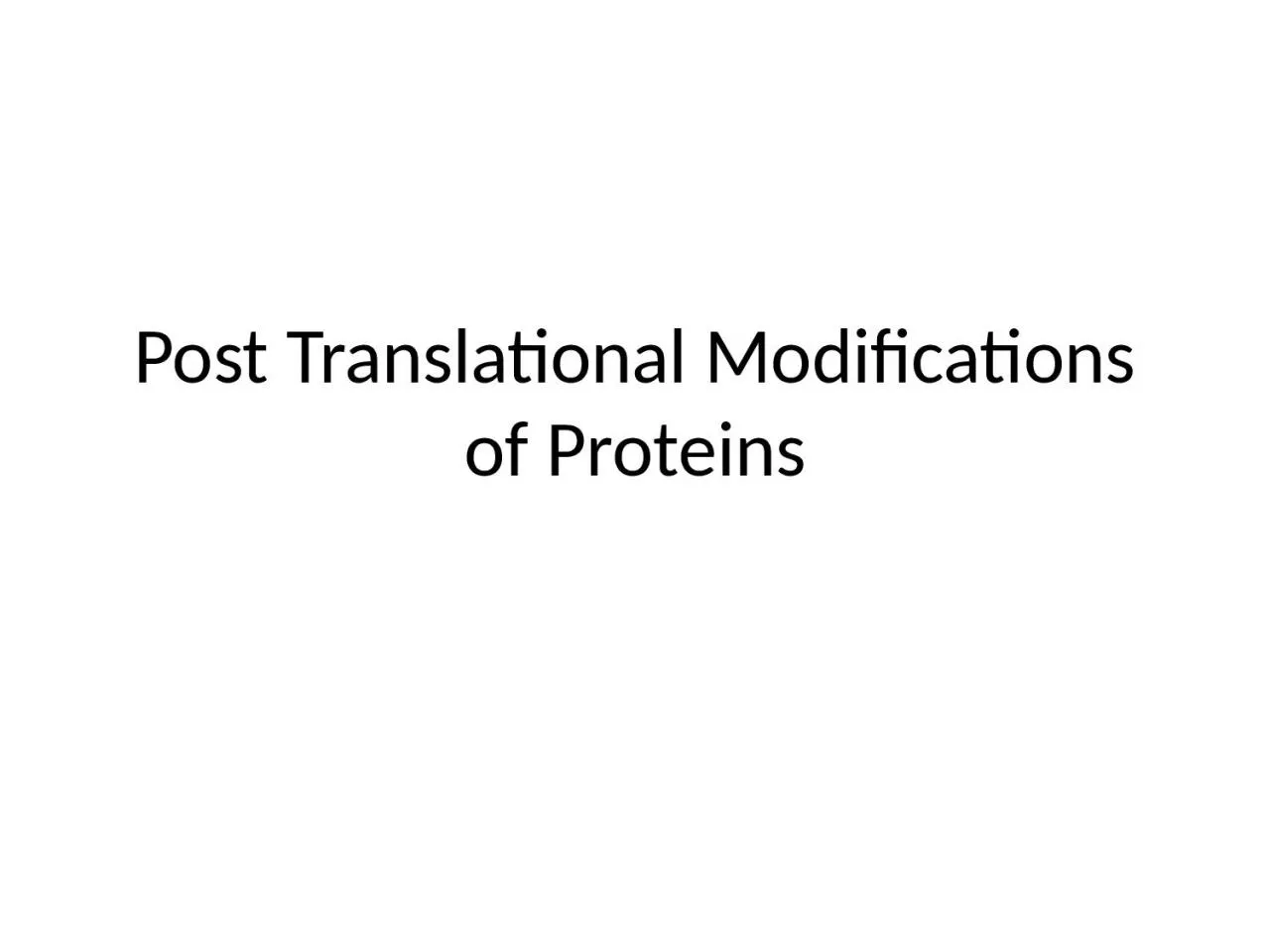

Phosphorylation Glycosylation Ubiquitination S Nitrosylation Methylation NAcetylation Lipidation Proteolysis Types of Post Translational Modifications Addition of phosphate group ID: 1038024
Download Presentation The PPT/PDF document "Post Translational Modifications of Prot..." is the property of its rightful owner. Permission is granted to download and print the materials on this web site for personal, non-commercial use only, and to display it on your personal computer provided you do not modify the materials and that you retain all copyright notices contained in the materials. By downloading content from our website, you accept the terms of this agreement.
1. Post Translational Modifications of Proteins
2. PhosphorylationGlycosylationUbiquitinationS-NitrosylationMethylationN-AcetylationLipidationProteolysisTypes of Post Translational Modifications.
3.
4. Addition of phosphate group to a protein.Principally on serine, threonine or tyrosine residues.Also known as Phospho regulation.Critical role in cell cycle, growth, apoptosis and signal transduction pathways.Phosphorylation Protein kinases ATP + protein ———————> phosphoprotein + ADP
5. Phosphorylation
6. Example
7. The covalent attachment of oligosaccharidesAddition of glycosyl group or carbohydrate group to a protein.Principally on Asparagine, hydroxylysine, serine or threonine.Significant effect on protein folding, conformation, distribution, stability and activity.Glycosylation
8. Example
9. N-Linked glycans attached to nitrogen of Asparagine or arginine side chains.O-Linked glycans attached to hydroxy oxygen of serine,threoninePhospho glycans linked through the phosphate of serine.C-Linked glycans Rare form, Sugar is added to a carbon on tryptophan side chain.Classes of Glycans
10. Ubiquitin is a small regulatory protein that can be attached to the proteins and label them for destruction. Effects in cell cycle regulation, control of proliferation and differentiation, programmed cell death (apoptosis), DNA repair, immune and inflammatory processes and organelle biogenesis.Ubiquitination
11. Ubiquitin cycle
12.
13. Nitrosyl (NO) group is added to the protein.NO a chemical messanger that reacts with free cysteine residues to form S-nitrothiols.Used by cells to stabilize proteins, regulate gene expression.S-Nitrosylation
14.
15. Addition of methyl group to a protein.Usually at lysine or arginine residues.Binds on nitrogen and oxygen of proteinsMethyl donor is S-adenosylmethionine (SAM)Enzyme for this is methyltransferaseMethylation of lysine residues in histones in DNA is important regulator of chromatin structureAlkylation/Methylation
16. ExampleWhere SAM (S-adenosyl methionine) is converted into SAH(S-adenosyl homocysteine)
17. Addition of acetyl group to the nitrogen.Histones are acetylated on lysine residues in the N-terminal tail as a part of gene regulation.Involved in regulation of transcription factors, effector proteins, molecular chaperons and cytoskeletal proteins.Methionine aminopeptidase (MAP) is an enzyme responsible for N-terminal acetylation N-Acetylation
18. Example
19. Where, HDACs = Histone deactyllase , KATs = N-acetyltransferase.
20. Lipidation attachment of a lipid group, such as a fatty acid, covalently to a protein. In general, lipidation helps in cellular localization and targeting signals, membrane tethering and as mediator of protein-protein interactions. Lipidation
21. C-terminal glycosyl phosphatidylinositol (GPI) anchorN-terminal myristoylationS-palmitoylationS-prenylationTypes of lipidation
22. C-terminal glycosyl phosphatidylinositol (GPI) anchorGPI anchors tether cell surface proteins to the plasma membraneGPI-anchored proteins are often localized to cholesterol- and sphingolipid-rich lipids, which act as signaling platforms on the plasma membrane.
23. N-myristoylationIt is the attachment of myristoyl group a 14-carbon saturated fatty acid (C14) to a protein.It is facilitated by N-myristoyltransferase (NMT) and uses myristoyl-CoA as the substrate.
24. S-palmitoylationIt is addition of C16 palmitoyl group from palmitoyl-CoA Palmitoyl acyl transferases (PATs) enzyme favors this step.Reversed by thioesterases
25.
26. S-prenylationAddition of a farnesyl (C15) or geranylgeranyl (C20) group to proteins.Enzyme involved in this reaction is farnesyl transferase (FT) or geranylgeranyl transferases (GGT I and II).
27. Disulfide BondingDisulfide bonds are covalent bonds formed between two cysteine residues (R-S-S-R). These bonds contribute to the correct folding of proteins as other elements of secondary structure
28. Disulfide Bonding
29. Cleavage of peptide bonds by proteases.Examples of Proteases- Serine Proteases, Cysteine Proteases, Aspartic acid Proteases.Involved in Antigen processing, Apoptosis, Cell signallingProteolysis
30.
31. Protein modifications can affect the protein involved in several different ways:Change protein conformation to activate of inhibit activityAlter association of the protein with other proteins in the cellInduce relocation of the protein between compartments of the cellAll of the above at once.